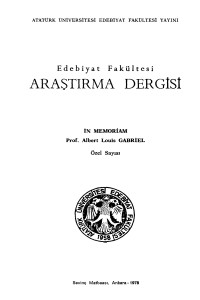Öz
Richard Ettinghausen’s revievv of Erdman’s Das Anatolische Karavansaray des 14. Jahrhunderts refers in passing «the public System of caravansarays run by the Sultan». Since the contemporary historians fail to mention them and only a few waqfiyyas of khâns (ali private foundations) survive, foundation inscriptions are the essential evidence for deciding which, if any, of the ninety eight caravansarays recorded by Erdmann West of Sivas formed part of the public System. Indisputably Royal foundations, with inscriptions clearly demonstrating that the Sultan alone was responsible, are exceptional. There are only five, vvhich is certainly an inadequate basis for a «public system»; so how are the other to be identified? It is tempting to identify som eof them by the inscription al-sultâıü («Royal»), not known outside Anatolia, which appears on a number of Seljuk buildings.
Anahtar Kelimeler
Kaynakça
- Kaynaklar makale içerisinde dipnot sistemi ile verilmiş şekilde yer almaktadır.
Öz
Richard Ettinghausen’s revievv of Erdman’s Das Anatolische Karavansaray des 14. Jahrhunderts refers in passing «the public System of caravansarays run by the Sultan». Since the contemporary historians fail to mention them and only a few waqfiyyas of khâns (ali private foundations) survive, foundation inscriptions are the essential evidence for deciding which, if any, of the ninety eight caravansarays recorded by Erdmann West of Sivas formed part of the public System. Indisputably Royal foundations, with inscriptions clearly demonstrating that the Sultan alone was responsible, are exceptional. There are only five, vvhich is certainly an inadequate basis for a «public system»; so how are the other to be identified? It is tempting to identify som eof them by the inscription al-sultâıü («Royal»), not known outside Anatolia, which appears on a number of Seljuk buildings.
Anahtar Kelimeler
Kaynakça
- Kaynaklar makale içerisinde dipnot sistemi ile verilmiş şekilde yer almaktadır.
Ayrıntılar
| Birincil Dil | İngilizce |
|---|---|
| Konular | Türk-İslam Sanatları Tarihi |
| Bölüm | Araştırma Makaleleri |
| Yazarlar | |
| Yayımlanma Tarihi | 4 Mart 2024 |
| Yayımlandığı Sayı | Yıl 1978 Sayı: 9 |
Bu eser Creative Commons Atıf-GayriTicari 4.0 Uluslararası Lisansı ile lisanslanmıştır.


